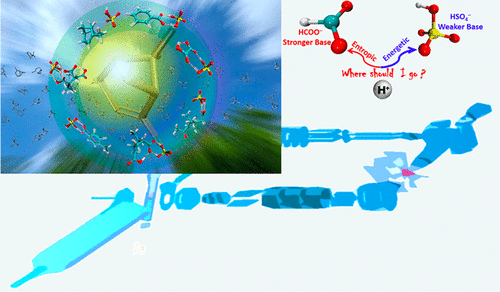当前位置:
X-MOL 学术
›
Acc. Chem. Res.
›
论文详情
Our official English website, www.x-mol.net, welcomes your
feedback! (Note: you will need to create a separate account there.)
Molecular Specificity and Proton Transfer Mechanisms in Aerosol Prenucleation Clusters Relevant to New Particle Formation
Accounts of Chemical Research ( IF 16.4 ) Pub Date : 2020-10-27 , DOI: 10.1021/acs.accounts.0c00444 Gao-Lei Hou 1 , Xue-Bin Wang 1
Accounts of Chemical Research ( IF 16.4 ) Pub Date : 2020-10-27 , DOI: 10.1021/acs.accounts.0c00444 Gao-Lei Hou 1 , Xue-Bin Wang 1
Affiliation

|
Atmospheric aerosol particles influence the Earth’s radiative energy balance and cloud properties, thus impacting the air quality, human health, and Earth’s climate change. Because of the important scientific and overarching practical implications of aerosols, the past two decades have seen extensive research efforts, with emphasis on the chemical compositions and underlying mechanisms of aerosol formation. It has been recognized that new particle formation (NPF) contributes up to 50% of atmospheric aerosols. Nowadays, the general consensus is that NPF proceeds via two distinct stages: the nucleation from gaseous precursors to form critical nuclei of sub-1–2 nm size, and the subsequent growth into large particles. However, a fundamental understanding of both the NPF process and molecular-level characterization of the critical size aerosol clusters is still largely missing, hampering the efforts in developing reliable and predictive aerosol nucleation and climate models.
中文翻译:

与新粒子形成有关的气溶胶预成核簇中的分子特异性和质子转移机制。
大气气溶胶颗粒会影响地球的辐射能平衡和云特性,从而影响空气质量,人类健康和地球的气候变化。由于气雾剂具有重要的科学意义和重要的实际意义,因此在过去的二十年中,人们进行了广泛的研究,重点是气溶胶的化学成分和潜在机理。已经认识到,新的颗粒形成(NPF)占大气气溶胶的50%。如今,一般的共识是,NPF经由两个不同的阶段进行:从气态前体成核形成亚临界晶核-1-2 nm大小,随后生长成大颗粒。但是,仍然缺少对NPF过程和临界尺寸气溶胶团簇的分子水平表征的基本了解,这妨碍了开发可靠且可预测的气溶胶成核和气候模型的努力。
更新日期:2020-12-15
中文翻译:

与新粒子形成有关的气溶胶预成核簇中的分子特异性和质子转移机制。
大气气溶胶颗粒会影响地球的辐射能平衡和云特性,从而影响空气质量,人类健康和地球的气候变化。由于气雾剂具有重要的科学意义和重要的实际意义,因此在过去的二十年中,人们进行了广泛的研究,重点是气溶胶的化学成分和潜在机理。已经认识到,新的颗粒形成(NPF)占大气气溶胶的50%。如今,一般的共识是,NPF经由两个不同的阶段进行:从气态前体成核形成亚临界晶核-1-2 nm大小,随后生长成大颗粒。但是,仍然缺少对NPF过程和临界尺寸气溶胶团簇的分子水平表征的基本了解,这妨碍了开发可靠且可预测的气溶胶成核和气候模型的努力。











































 京公网安备 11010802027423号
京公网安备 11010802027423号